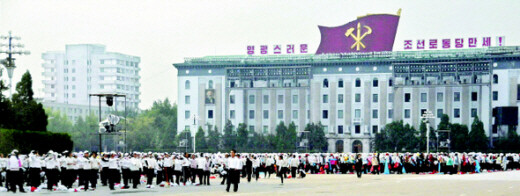hankyoreh
Links to other country sites 다른 나라 사이트 링크
Kim Jong-un emerges from shroud of secrecy

By Kwon Hyuk-chul, Staff writer
It was around January 2009 when it first became known that Kim Jong-un, the third son of North Korean leader Kim Jong-il, had been unofficially selected as his father’s successor. One year and eight months later, North Korea seems to have begun the process of making his succession official, with the younger Kim receiving the title of general of the Korean People’s Army. However, North Korea has essentially never made any information public about Kim Jong-un to the outside world.
Kim Jong-un is the second son of Kim Jong-il with his third wife Ko Yong-hui, who died in 2004. It has been confirmed by various sources that his birthday is Jan. 8, but his precise date of birth is not known. With different sources reporting 1981, 1982, 1983, or 1984 as his year of birth, experts and intelligence authorities consider 1983 to be the most likely.
Until the early 2000s, most North Korea experts were focusing on Kim Jong-il’s eldest son Kim Jong-nam as a likely successor to the North Korean leadership. Sources indicated that Kim Jong-nam was excluded from the succession framework after his deportation from Japan in 2001 following illegal entry into the country.
Subsequently, experts predicted that Kim Jong-il’s second son and Kim Jong-un’s older brother, Kim Jong-chul, was the likely candidate. In the early 2000s, Kim Jong-chul worked as a department chief in the organizational leadership of the Workers’ Party of Korea(WPK) Central Committee, but Kim Jong-il is reported to have turned his attentions to Jong-un when Jong-chul proved weak and politically inept.
It was in early 2006 that intelligence organizations in South Korea and overseas began taking the view that Kim Jong-un would likely be named as a successor, since he was the most favored by his father and had the strongest drive and leadership. Kim Jong-un reportedly bears a close facial resemblance to Kim Jong-il and has a similar frame and personality.
In early January 2009, after Kim Jong-un was unofficially named as a successor, a song in praise of him entitled “Balgeoreum,” Footstep, began being distributed in North Korea, and he reportedly accompanied his father on field inspections and participated in policy decisions.
At a June 2009 meeting of the National Assembly intelligence committee, the National Intelligence Service (NIS) reported that North Korea had notified Kim Jong-un’s unofficial nomination as a successor to overseas government offices and that songs in praise of Kim Jong-un were being distributed and recitation contests held in North Korea.
The June 30 edition of North Korea’s Rodong Sinmun newspaper included a reappearance of the expression dangjungang, party center, which was previously used in 1974 when Kim Jong-il was first unofficially selected as a successor.
Recently, the term “CNC,” referring to computer numerical control technology, has reportedly been frequently used in North Korea and is understood to be a symbol for Kim Jong-un. The mass gymnastics and artistic performance Arirang, held in early August, also included a card section spelling out the slogan “CNC, the power of juche industry.”
Kim Jong-un is also known to have studied at public middle and high schools in Bern, Switzerland, from summer 1996 to January 2001. Sources report that he got along well with his classmates during his study in Switzerland, that he was diligent and ambitious, and that his hobby was basketball.
Experts surmise that following his return to North Korea in 2001, he studied military studies at the Kim Il-sung Military University from 2002 to December 2006. This university is an institution for training military leaders.
Please direct questions or comments to [englishhani@hani.co.kr]
Editorial・opinion
![[Column] Season 2 of special prosecutor probe may be coming to Korea soon [Column] Season 2 of special prosecutor probe may be coming to Korea soon](https://flexible.img.hani.co.kr/flexible/normal/500/300/imgdb/original/2024/0426/3317141030699447.jpg) [Column] Season 2 of special prosecutor probe may be coming to Korea soon
[Column] Season 2 of special prosecutor probe may be coming to Korea soon![[Column] Park Geun-hye déjà vu in Yoon Suk-yeol [Column] Park Geun-hye déjà vu in Yoon Suk-yeol](https://flexible.img.hani.co.kr/flexible/normal/500/300/imgdb/original/2024/0424/651713945113788.jpg) [Column] Park Geun-hye déjà vu in Yoon Suk-yeol
[Column] Park Geun-hye déjà vu in Yoon Suk-yeol- [Editorial] New weight of N. Korea’s nuclear threats makes dialogue all the more urgent
- [Guest essay] The real reason Korea’s new right wants to dub Rhee a founding father
- [Column] ‘Choson’: Is it time we start referring to N. Korea in its own terms?
- [Editorial] Japan’s rewriting of history with Korea has gone too far
- [Column] The president’s questionable capacity for dialogue
- [Column] Are chaebol firms just pizza pies for families to divvy up as they please?
- [Column] Has Korea, too, crossed the Rubicon on China?
- [Correspondent’s column] In Japan’s alliance with US, echoes of its past alliances with UK
Most viewed articles
- 1Samsung subcontractor worker commits suicide from work stress
- 2‘We must say no’: Seoul defense chief on Korean, USFK involvement in hypothetical Taiwan crisis
- 3Is Japan about to snatch control of Line messenger from Korea’s Naver?
- 4Division commander ordered troops to enter raging flood waters before Marine died, survivor says
- 5[Editorial] Korea’s surprise Q1 growth requires objective assessment, not blind fanfare
- 6No good, very bad game for Korea puts it out of Olympics for first time since 1988
- 7US overtakes China as Korea’s top export market, prompting trade sanction jitters
- 8Korea’s 1.3% growth in Q1 signals ‘textbook’ return to growth, says government
- 9N. Korean delegation’s trip to Iran shows how Pyongyang is leveraging ties with Moscow
- 10[Column] Season 2 of special prosecutor probe may be coming to Korea soon